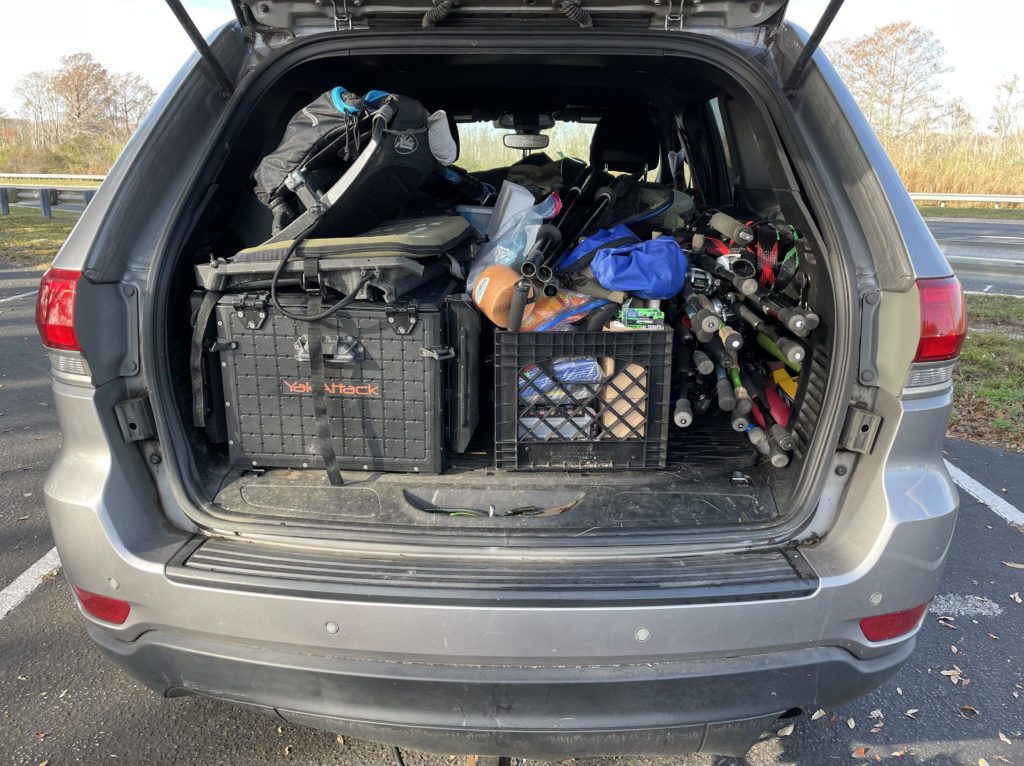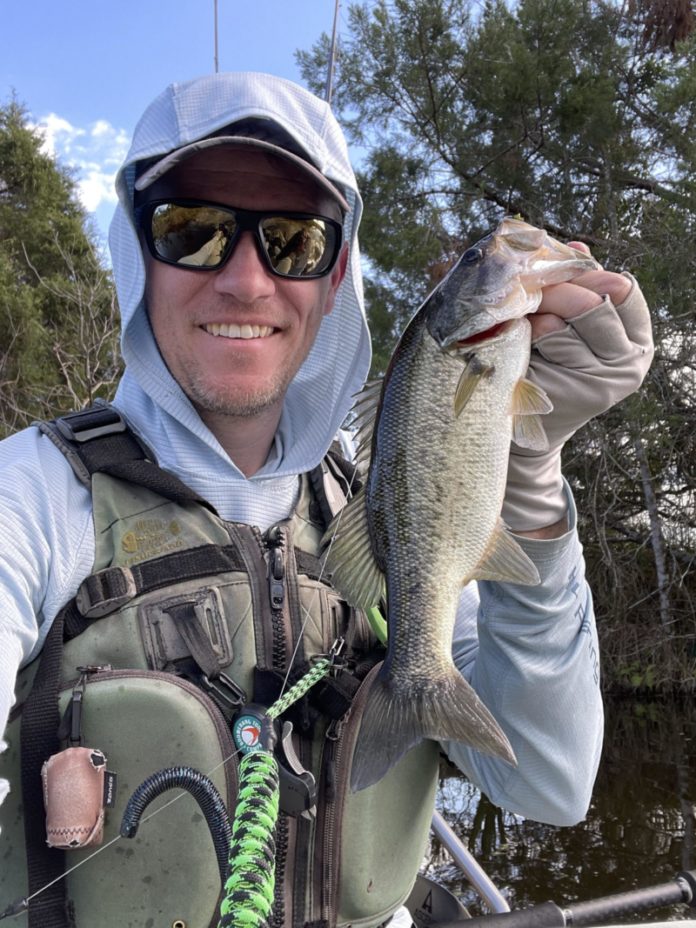One of the appealing things about kayak fishing is its simplicity. My first kayak was lightweight and basic. I would often store it on top of my car and stop by the river on my way home from work. On those trips I typically only brought a paddle, a Plano box, a few bags of plastics, and two or three rods. Those short trips were so much fun, and I learned a lot just by getting on the water frequently. Over the years, I’ve found myself missing that simplicity. As I upgraded to a bigger kayak, purchased additional rods and reels, and added more tackle, getting on the water became more of a chore. Eventually, I reached a point where I stopped taking the shorter trips. It took so long to launch the boat and get all my stuff into it, that I was spending more time getting ready than actually fishing. Getting into competitive kayak fishing only exacerbated the problem for me. Now there was money on the line, so I needed to pack every possible lure into the kayak. If I was fishing a plastic worm, I’d bring three bags of each color just to make sure I didn’t run out. So much clutter!
In the summer of ‘21, I befriended an angler at a KBF tournament who was relatively new to bass fishing. He fished with a pair of spinning rods and a handful of baits. No depth finder, motor or other high-tech gear. Just a kayak, a paddle, and a couple of poles. That was it. Seeing the simplicity of his system was refreshing and reminded me of those quick fishing trips after work, back when my own style was less complicated. It motivated me to rethink my approach.
Fast forward eighteen months or so and I’ve made some progress. I still own a mountain of tackle, but I’ve gotten better about limiting what I bring with me on the kayak. Shrinking my tackle selection has been refreshing. It’s had a positive impact on my fishing too. My theory is that decluttering my boat also decluttered my head. I’ve found myself thinking less about lures and more about where I’m going to throw them. Are the fish deep or shallow? Are they high in the water column or tight to the bottom? What is their mood? Are they lethargic or aggressive? Answering these questions became easier when I wasn’t so focused on cycling through fifty different baits.
So, if you’re a tackle junkie like me, looking for ways to simplify things, here are a few ideas. First, take fewer rods. When I’m traveling for a tournament, I almost always bring 15-20 rods with me, but I started limiting myself to just six in the kayak. It’s nice to have rods rigged for a variety of techniques, plus a few spares, but it becomes counterproductive when you have too many in the kayak. The more rods I have sticking up or out at different angles, the more likely I am to tangle in an overhanging limb or clip a rod during a cast. Those clumsy casts often end with a backlash, line break or even a broken tip. With six rods or fewer I’m more efficient. That said, everyone is different, and we use different kayaks. I have a Hobie Outback, which I’ll call a midsize boat. Some larger kayaks, like the Pro Angler models, have options for storing rods horizontally on the deck. Other boats have open space inside the hull. If you have one of these, you might be able to effectively manage more rods. If you run a smaller river kayak, it might be cumbersome to store more than four rods. Figure out what the ideal number is for your boat size and fishing style. Then try taking one fewer rod than you normally would and see how it goes.

I have a similar approach when it comes to tackle. I take a lot of gear on the road, but I limit what comes in the kayak. I have stacks of Plano boxes in milk crates, each dedicated to a different technique. There are boxes of crankbaits grouped by running depth, a wakebait box, a jerkbait box, and so on. When it’s fishing time, I’ll grab a couple of empty boxes and stock them with a few baits from each master box. Baits with treble hooks go in a waterproof 3600 or 3700 series box. I like a Plano 3440 box for holding jigs, chatterbaits, and spinnerbaits. Limiting myself to just two boxes cuts down on weight and simplifies my lure selection, which helps me focus on figuring out the fish without getting too wrapped up in bait details. If there’s a good crankbait bite in practice, for example, I’ll catch fish even if I don’t have the perfect action, size, or color. Once I find that the technique is working, then I can start to refine the details. Am I getting more bites with a wider wobble or a tighter action? Are natural colors or bold ones producing better? My day boxes get modified each morning as needed. I’ll add to the bait categories that worked, and I may eliminate unproductive baits, but not always. For competition days, I’ll keep at least one or two baits from key categories – a spinnerbaits and buzzbaits for example – in the kayak even if they didn’t work during practice. If conditions change, I need to have the tools to adjust and capitalize.
Soft plastics are another area where I’ve tried to simplify things. I used to carry beaver style baits from several different brands. I did the same for creature baits, straight tail worms, craws and most other plastics. Last year I decided to limit myself to a single bait in each category. That significantly reduced the amount of tackle I was carrying. My thinking was simple. I just need one tool for the job. If I have the Missile Baits Craw Father, I don’t need craws from three other brands too. They all do the same job, so I forced myself to pick one. Then I did the same for every other category. Did my now-retired baits catch fish? Absolutely. Did I need them? Nope. At first, I was worried that limiting my soft plastics options would leave me unprepared. Instead, it made me more efficient. If fish aren’t biting my Missile 48, I don’t try other stickworms, I change techniques or locations. If they won’t eat a Bomb Shot, once again I change areas or switch techniques. No more cycling through ten different drop shot baits.
Another area where I’ve tried to simplify, color selection. Admittedly, it’s been a struggle trying to limit my colors for soft plastics. There are so many awesome looking colors out there, and I like having a wide array so that I can pick the absolute perfect lure for the water color I’m facing. But I’ve realized that this obsession is probably counterproductive. It’s overkill. On a trip last fall, I ran into a good flipping bite and started experimenting. I used the same bait in several different colors – green pumpkin, junebug, Okeechobee craw – and caught fish on every single one. They all worked. Are there times when color makes a difference? Sure, but I think we overcomplicate it. I know that I can get by with just a few. I need a dark color like black/blue or junebug for dirty water, a translucent one like watermelon red or candy grass for clear water, and some variation of green pumpkin for everything in between. That’s it. I could probably even limit myself to just green pumpkin and still catch a boatload of fish, but I’m not there yet. Don’t judge. And don’t be like me. Limit your color selection and make your kayak faster.
One final tip for soft plastics. I like the Bass Mafia Money Bags for holding bulk plastics, like my D Bombs and Baby D Bombs. but it’s not efficient to bring these bulk bags in the kayak. So, I grab two or three baits in my favorite colors and put them in a quart sized Ziplock bag. This sample pack works well for practice, allowing me to try a few different colors without the added weight of the bulk bags. A word of caution, be careful about mixing reds and whites in the same bag. These colors tend to bleed, so you could end up with reds and pinks. For other colors, these sample bags are a winner.
If you’re one of those anglers who gets buy with a rod or two and a handful of baits, I salute you. You probably didn’t need to read this. For everyone else, I hope this gave you a few ideas to streamline your fishing. Maybe you’ll end up at a flea market, trying to sell some of your excess tackle. Or maybe you just enjoyed hearing from someone who’s tackle addiction is worse than yours. Regardless of where you are on the spectrum, remember to keep it simple this season.

